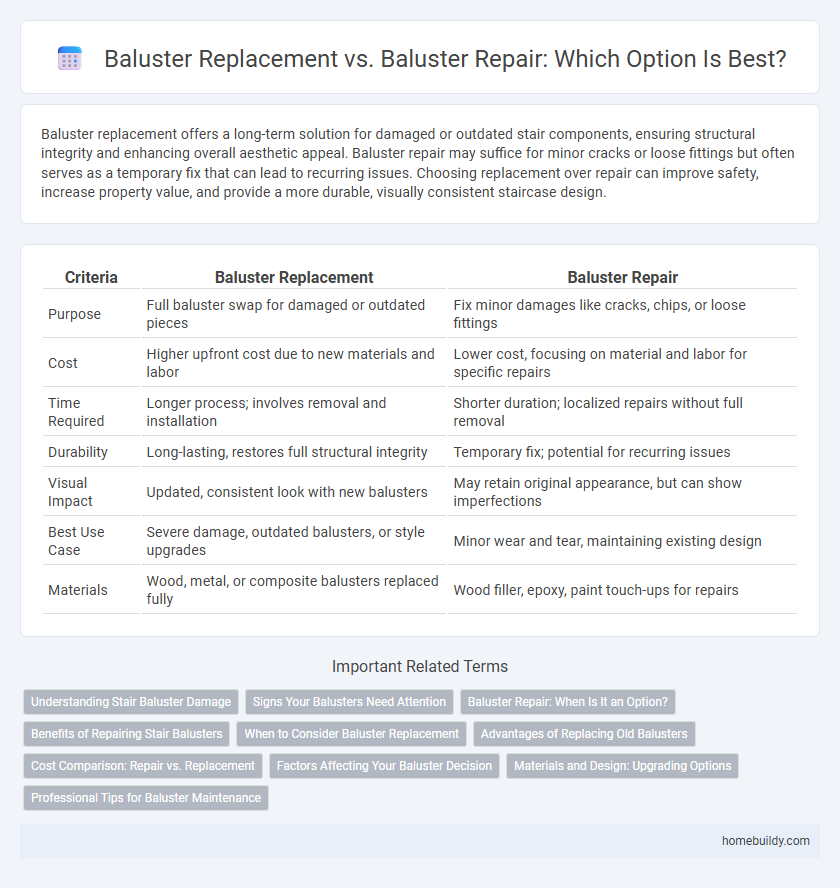Baluster replacement offers a long-term solution for damaged or outdated stair components, ensuring structural integrity and enhancing overall aesthetic appeal. Baluster repair may suffice for minor cracks or loose fittings but often serves as a temporary fix that can lead to recurring issues. Choosing replacement over repair can improve safety, increase property value, and provide a more durable, visually consistent staircase design.
Table of Comparison
| Criteria | Baluster Replacement | Baluster Repair |
|---|---|---|
| Purpose | Full baluster swap for damaged or outdated pieces | Fix minor damages like cracks, chips, or loose fittings |
| Cost | Higher upfront cost due to new materials and labor | Lower cost, focusing on material and labor for specific repairs |
| Time Required | Longer process; involves removal and installation | Shorter duration; localized repairs without full removal |
| Durability | Long-lasting, restores full structural integrity | Temporary fix; potential for recurring issues |
| Visual Impact | Updated, consistent look with new balusters | May retain original appearance, but can show imperfections |
| Best Use Case | Severe damage, outdated balusters, or style upgrades | Minor wear and tear, maintaining existing design |
| Materials | Wood, metal, or composite balusters replaced fully | Wood filler, epoxy, paint touch-ups for repairs |
Understanding Stair Baluster Damage
Stair baluster damage often manifests as cracks, looseness, or rot, which can compromise both safety and aesthetics. Baluster replacement ensures complete restoration by removing the damaged unit and installing a new, sturdy baluster, ideal for severe structural issues. Repairing a baluster may involve gluing cracks, tightening loose connections, or refinishing surfaces, suitable for minor cosmetic or stability concerns.
Signs Your Balusters Need Attention
Visible cracks, wobbling, or loose fittings are clear signs your stair balusters need replacement rather than repair. Warped wood, extensive rot, or missing sections compromise structural integrity, signaling that repairs won't restore safety or appearance. Consistent inspection for these issues ensures timely baluster replacement, maintaining stair stability and aesthetic appeal.
Baluster Repair: When Is It an Option?
Baluster repair is an option when damage is limited to minor cracks, loose fittings, or superficial wear that does not compromise structural integrity. Repairing rather than replacing can preserve original materials, maintain aesthetic consistency, and reduce costs. Assessing the baluster's condition and consulting with a professional ensures repair effectiveness and long-term safety.
Benefits of Repairing Stair Balusters
Repairing stair balusters preserves the original aesthetic and architectural integrity of the staircase, maintaining its historic value and charm. It is often more cost-effective than full baluster replacement, reducing material costs and labor time while minimizing disruption. Repair also helps to retain structural stability by addressing specific damage, preventing further deterioration without compromising the overall balustrade system.
When to Consider Baluster Replacement
Baluster replacement is necessary when structural damage, extensive rot, or severe cracking compromises the safety and stability of the stair railing. Minor surface damage like scratches or loose fittings can often be resolved through baluster repair, but visible warping or broken balusters require full replacement. Inspecting the balusters regularly helps identify when repair is no longer sufficient and replacement is essential to maintain code compliance and prevent accidents.
Advantages of Replacing Old Balusters
Replacing old stair balusters enhances structural safety by ensuring stability with modern materials and secure fittings. New balusters improve aesthetic appeal, offering updated designs that complement current interior styles and increase property value. Replacement also reduces long-term maintenance costs by eliminating recurring repairs often associated with worn or damaged balusters.
Cost Comparison: Repair vs. Replacement
Baluster replacement typically involves higher upfront costs, averaging $30 to $75 per baluster, due to material and labor expenses, while baluster repair can range from $15 to $40 depending on damage severity and required materials. Repairing balusters often provides a cost-effective solution for minor cracks or loosened fittings, minimizing immediate expenses but potentially leading to more frequent maintenance. Replacement ensures long-term durability and updated aesthetics, justifying the initial investment for structurally compromised or outdated balusters.
Factors Affecting Your Baluster Decision
Baluster replacement and repair decisions depend on material durability, extent of damage, and cost-effectiveness. Wood balusters often require more frequent repairs due to rot or insect damage, while metal or fiberglass options may favor replacement when corrosion or structural compromise occurs. Assessing the baluster's age, safety concerns, and aesthetic goals helps determine whether repair preserves structural integrity or if replacement ensures long-term stability.
Materials and Design: Upgrading Options
Baluster replacement offers the opportunity to choose from advanced materials like stainless steel, glass, or composite, enhancing durability and modern aesthetics beyond traditional wood or wrought iron. Repairing existing balusters maintains the original design but limits upgrades to surface treatments or minor structural fixes without changing material composition. Selecting replacement balusters supports incorporating contemporary design trends and improved safety standards, while repair prioritizes preserving historic or custom craftsmanship.
Professional Tips for Baluster Maintenance
Baluster replacement ensures the structural integrity and aesthetic appeal of staircases, especially when wood rot or severe damage is present. Baluster repair is a cost-effective solution for minor cracks, loose fittings, or surface wear, extending lifespan and maintaining safety. Professionals recommend routine inspections, using weather-resistant finishes, and tightening fasteners regularly to optimize baluster durability.
baluster replacement vs baluster repair Infographic

 homebuildy.com
homebuildy.com